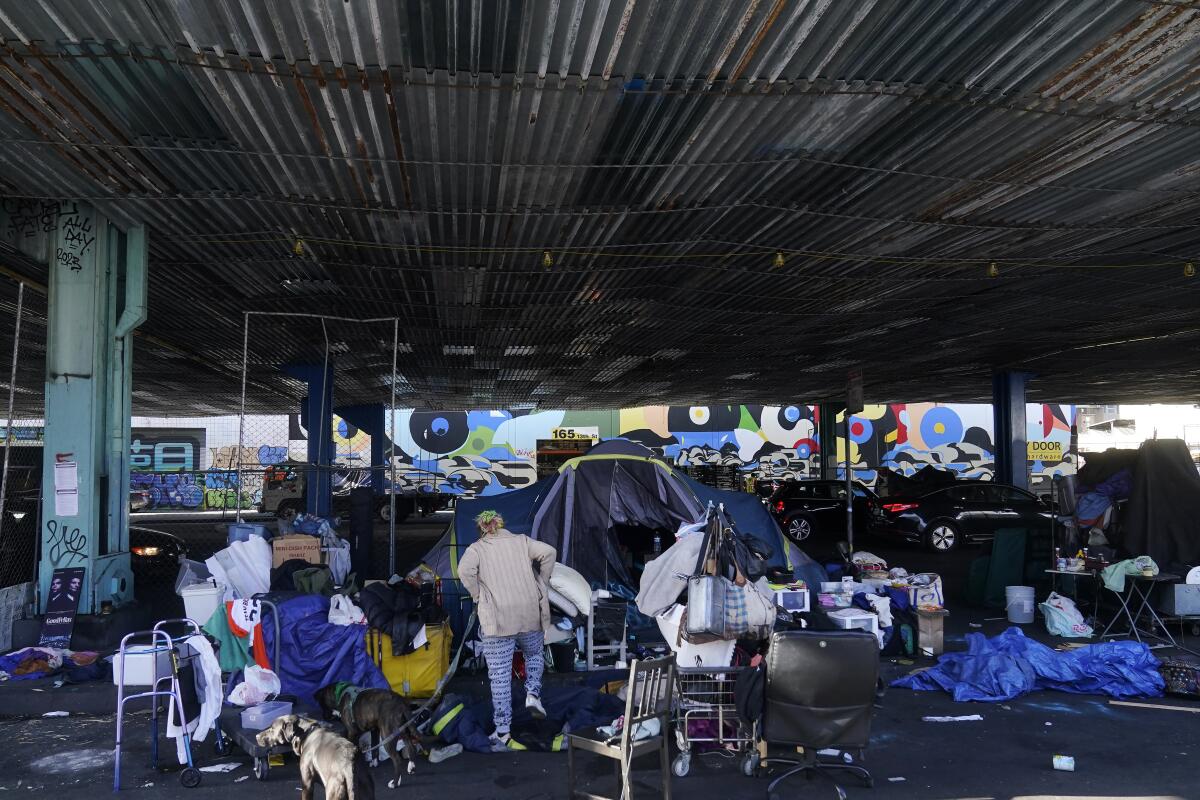How will Supreme Court ruling on homeless camps affect California? Cities across state weigh in

The Supreme Court on Friday ruled that cities in California and the West may enforce laws restricting homeless encampments on sidewalks and other public property.
The justices disagreed with the U.S. 9th Circuit Court of Appeals in San Francisco and ruled it is not “cruel and unusual” punishment for city officials to forbid homeless people from sleeping on the streets or in parks.
California Gov. Gavin Newsom and city attorneys from Los Angeles, San Francisco, San Diego and Phoenix were among two dozen government and business groups that urged the high court to hear the appeal in Grants Pass vs. Johnson and overturn the 9th Circuit.
While Newsom and others welcomed the ruling, it’s been a controversial topic that’s differentiated the more moderate wing of the Democratic Party from the progressives.
How will this ruling change the way California officials deal with homeless encampments?
The 9th Circuit Court, whose jurisdiction covers nine states in the West, has recognized constitutional protections for those who are homeless and have no place to sleep. It remains the only federal appellate court in the nation to do so.
In a series of rulings, the court has held that cities violate the 8th Amendment’s ban on cruel and unusual punishment when police arrest or fine people who have no access to shelter.
The Supreme Court ruling is a significant victory for city officials in the West and a setback for homeless rights advocates. Since 2018, the advocates had won rulings from the 9th Circuit that held it was unconstitutional to enforce anticamping laws against people who had no home and nowhere else to sleep.
While nothing in the decision requires cities to take stronger enforcement action against homeless people, it will free some of them to do so.
Is it really up to local governments to decide how to deal with this?
Yes.
Justice Neil M. Gorsuch wrote that people will disagree over which policy responses are best. Cities might experiment with one set of approaches only to later find that another set works better and might find certain responses more appropriate for some communities than others.
“But in our democracy, that is their right,” he added.
“Homelessness is complex,” he wrote. “Its causes are many. So may be the public policy responses required to address it. At bottom, the question this case presents is whether the 8th Amendment grants federal judges primary responsibility for assessing those causes and devising those responses. It does not.”
Newsom said in a statement that the ruling provides state and local officials “the definitive authority to implement and enforce policies to clear unsafe encampments from our streets.”
“This decision removes the legal ambiguities that have tied the hands of local officials for years and limited their ability to deliver on common-sense measures to protect the safety and well-being of our communities,” he said.
What is the view from L.A. City Hall?
Los Angeles Mayor Karen Bass slammed the Supreme Court’s ruling, calling it “disappointing” and arguing that it should not be used to jail homeless residents or drive them from city to city.
Bass, who declared an emergency on homelessness on her first day in office in December, signaled the ruling will not alter her approach to the crisis, which has focused heavily on moving unhoused Angelenos out of encampments and into hotels, motels and other forms of temporary housing.
Arresting homeless people or pushing them out of a community and into another city is “more expensive for taxpayers than actually solving the problem,” Bass said in a statement.
“The only way to address this crisis is to bring people indoors with housing and supportive services,” she said. “In the city of Los Angeles, we will continue leading with this approach, which helped move thousands more Angelenos inside last year than the year before.”
Bass made homelessness her top priority upon taking office in December 2022. Her Inside Safe initiative has tackled some of the city’s largest and most entrenched encampments.
Inside Safe is billed as a voluntary program, with homeless residents given a choice from outreach workers on whether to move indoors. However, the city also has a law, Municipal Code 41.18, that prohibits homeless people from sleeping or setting up tents in certain locations.
Under the law, homeless people can be cited if they set up tents within 500 feet of schools or day-care centers. It also bars encampments from coming within two feet of a fire hydrant, five feet of a doorway or 10 feet of a driveway.
The city law also prohibits encampments from blocking wheelchair access. And it allows the City Council to designate certain “sensitive” areas, such as libraries, senior centers and freeway overpasses, as off-limits to encampments.
What are officials in other cities saying?
In a phone interview, Lancaster Mayor R. Rex Parris said the high court “finally made a good ruling” and said the city plans to “be much more aggressive.” Parris added that he’s not concerned about “appropriate encampments,” but is concerned about those “who camp next to neighborhoods, next to shopping centers.”
“We’re going to be moving them really fast,” he said. He added that the city has a “state-of-the-art homeless shelter” with beds available.
“Admittedly, our issues are different than downtown L.A., because we have 96 square miles and only a third of it is developed. There’s a lot of places these people can camp, it doesn’t have to be in our frontyard,” Parris said. “In L.A. that might not always be the case, you don’t have a lot of options.”
He added that “that is not an invitation for them to send their homeless to us.”
Parris agreed with Gorsuch that the decision should be in the hands of city officials, stating, “that’s called democracy.”
“It’s a local government decision,” he said. “If the federal government would stay out of our way on most of the decisions we have to make, it would be so much easier.”
In San Diego, one of the cities that urged the Supreme Court to hear the appeal, Mayor Todd Gloria said the ruling “brings much-needed clarity to how the city can enforce our laws against unsafe encampments.”
However, he added that “it will not change our strategy on homelessness.”
“It is clear that the 1,000 new shelter opportunities we’ve added in the past three years is working to reduce street homelessness, and we intend to continue to pursue additional beds,” he said in a statement.
San Francisco Mayor London Breed, who had welcomed the Supreme Court’s review of the case in her broader effort over the last year to crack down on crime and homelessness in the city, said the decision “will help cities like San Francisco manage our public spaces more effectively and efficiently.”
Breed has long lamented that, despite the city funneling more resources into temporary housing and treatment services, those on the streets often refuse shelter.
An estimated 8,323 people are homeless in San Francisco, a city of about 808,000. The growing number of tents and visible homelessness in neighborhoods such as the Tenderloin or South of Market has become a focal point in Breed’s uphill battle for reelection this November against four other serious challengers, including two centrist candidates who have largely based their campaigns on blaming Breed for the worsening street conditions.
“San Francisco has made significant investments in shelter and housing, and we will continue to lead with offers of services from our hard-working city employees,” Breed said in a prepared statement. “But too often these offers are rejected, and we need to be able to enforce our laws, especially to prevent long-term encampments.”
Breed said the city will now adjust its policies in alignment with the ruling, which she says will help city departments and outreach workers more effectively do their jobs. The mayor said those who refuse help or already have shelter will no longer “be allowed to camp on our streets.”
In Sacramento, Mayor Darrell Steinberg has similarly struggled to rein in homelessness and mitigate deteriorating downtown street conditions. In a statement after the ruling, Steinberg said unsheltered homelessness had fallen 41% between 2022 and 2024 “due to our strategy of combining more shelter, housing and services with an insistence that people cannot live in large encampments and violate ordinances protecting sidewalks, parks and other critical spaces.”
“This court ruling should not change our balanced, compassionate approach,” Steinberg said.
More to Read
Sign up for Essential California
The most important California stories and recommendations in your inbox every morning.
You may occasionally receive promotional content from the Los Angeles Times.













